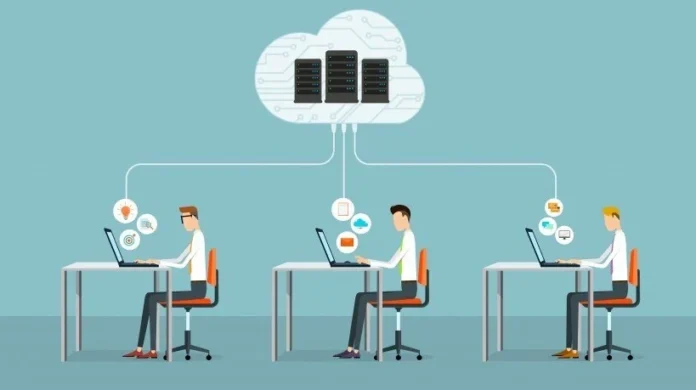In today’s fast-paced world, organizations constantly seek ways to enhance their employees’ skills and knowledge. One way to do so is through training and development programs. However, with traditional methods, such as classroom-based training, becoming less effective and efficient, organizations are turning to technology-driven solutions, such as cloud-based Learning Management Systems (LMS), to streamline their training needs.
This post will explore how cloud-based Learning Management Systems can help organizations streamline their training needs.
Introduction to Cloud-Based Learning Management System

A Learning Management System is software that facilitates the administration, documentation, tracking, reporting, and delivery of educational courses, training programs, or learning and development programs. A cloud-based Learning Management System is a program hosted on a cloud server and accessible online. This means that users can access the program from anywhere, at any time, and on any device with an internet connection.
Benefits
1. Scalability
One benefit of using a cloud-based system is scalability. Traditional training methods, such as classroom-based training, have limitations regarding the number of learners that can attend a session. However, with a cloud-based one, an organization can scale its training program to accommodate any number of learners, from a few to thousands, without additional infrastructure costs.
2. Accessibility
Cloud-based Learning Management Systems offer accessibility to learners, making it easier for them to access training content from any location, at any time, and on any device. This means that people can access the training content at their own pace, enabling them to learn at a pace that suits them best. The accessibility of such applications also reduces the need for employees to travel to attend training sessions, saving time and money for both employees and the organization.
3. Tracking and Reporting
Cloud-based systems offer advanced tracking and reporting features that allow organizations to track progress, measure the effectiveness of their training programs, and generate reports on various metrics, such as completion rates, assessment scores, and learner engagement. This information can be used to identify knowledge gaps, improve training content, and develop targeted training programs.
4. Flexibility
The flexibility of these systems is one of its main advantages over traditional methods such as paper-based tests or training materials. Cloud-based LMSs allow users to access the system from anywhere with internet access and facilitate anytime/anywhere learning for busy students who appreciate the convenience of studying on their own schedule. Additionally, it provides educators with greater flexibility in how they deliver their content by allowing them to easily update materials according to student needs.
5. Cost Savings
Cloud-based Learning Management Systems are also beneficial in that they can save organizations money by eliminating hardware costs associated with other solutions such as hardware for physical classrooms or expensive software licenses for developing courses on existing platforms. Additionally, they offer a convenient platform for delivering Cloud Training Courses for Teams and Individuals, allowing organizations to access a wider range of courses, and individuals to benefit from learning anytime and anywhere with just an internet connection, for more info click here. Furthermore, because these systems are hosted in the cloud there is no need for ongoing server maintenance costs making them more cost-effective than other solutions over time due to reduced upfront costs associated with purchasing hardware dedicated servers etc…
Personalized Learning with Cloud-Based LMS

Personalized learning is a growing trend in education and training, and cloud-based learning management systems (LMS) can help deliver tailored learning experiences. With cloud-based LMS, learners can receive personalized content, based on their specific needs and preferences. This can include personalized learning paths, recommendations, and assessments.
Cloud-based LMS can collect data on learners, such as their previous performance, learning pace, and preferred learning styles. This information can then be used to personalize the learning experience, ensuring that learners receive the most relevant and effective training materials.
Personalized learning with cloud-based LMS can improve learner engagement, motivation, and retention. By tailoring content to the needs of the learner, the training becomes more relevant and interesting. Furthermore, personalized learning can lead to better learning outcomes, as learners are more likely to apply what they have learned in their work.
Overall, cloud-based LMS can provide a powerful platform for delivering personalized learning experiences. By leveraging the data and tools available, organizations can optimize training for their learners, resulting in better engagement, retention, and performance.
Ensuring Security and Compliance

One way to ensure security and compliance is by selecting a reputable cloud-based LMS vendor that adheres to industry-standard security protocols. The LMS vendor should provide a secure infrastructure, with robust encryption, access controls, and disaster recovery procedures. Organizations should also ensure that their cloud-based LMS is compliant with relevant regulations, such as GDPR or HIPAA, depending on their industry and jurisdiction.
Another way to ensure security and compliance is by implementing strict access controls for the cloud-based LMS. This includes implementing password policies, multi-factor authentication, and role-based access controls. Organizations should also monitor user activity and audit logs to detect any suspicious activity.
Lastly, organizations should ensure that their employees are aware of security and compliance best practices when using the cloud-based LMS. This includes regular security training, data protection policies, and guidelines for secure data handling.
Implementation
- Selecting the right provider: Organizations must choose a provider with features and functionalities aligning with their training needs and objectives. Evaluating multiple providers and comparing their offerings is essential before selecting one.
- Customization: Organizations must customize the application to suit their training needs once the provider is selected. This involves creating personalized learning paths, defining learning objectives, and developing training content that aligns with the organization’s business goals.
- Training and Onboarding: Organizations must train their workers to use the application effectively after customizing the system. This includes providing training on accessing the software, navigating the interface, and completing training courses. Onboarding new employees onto the system is also essential to ensure they can access the training content and get up to speed with the organization’s training programs.
- Tracking and Reporting: Once the application is in place, organizations must track learners’ progress and generate reports on various metrics, such as completion rates, assessment scores, and learner engagement. This information can be used to identify knowledge gaps, improve training content, and develop targeted training programs.
Conclusion
Cloud-based LMS offers many benefits to help organizations streamline their training needs. It can provide a more effective and efficient way to deliver training programs. By following the steps outlined in this post, organizations can implement a cloud-based Learning Management System that aligns with their training needs and objectives and provides their employees with the skills and knowledge they need to succeed.







